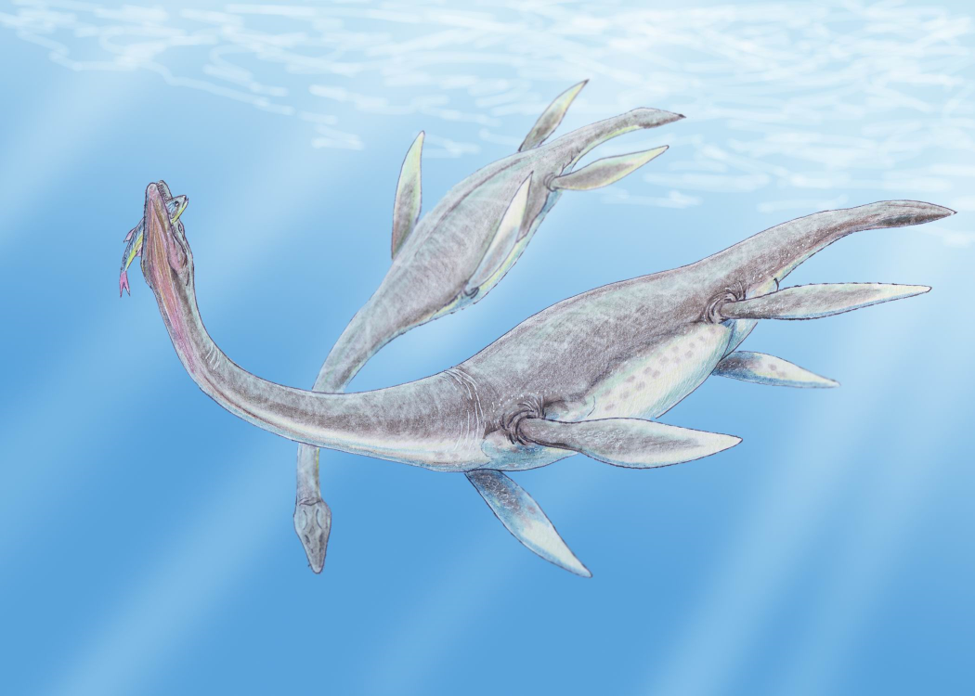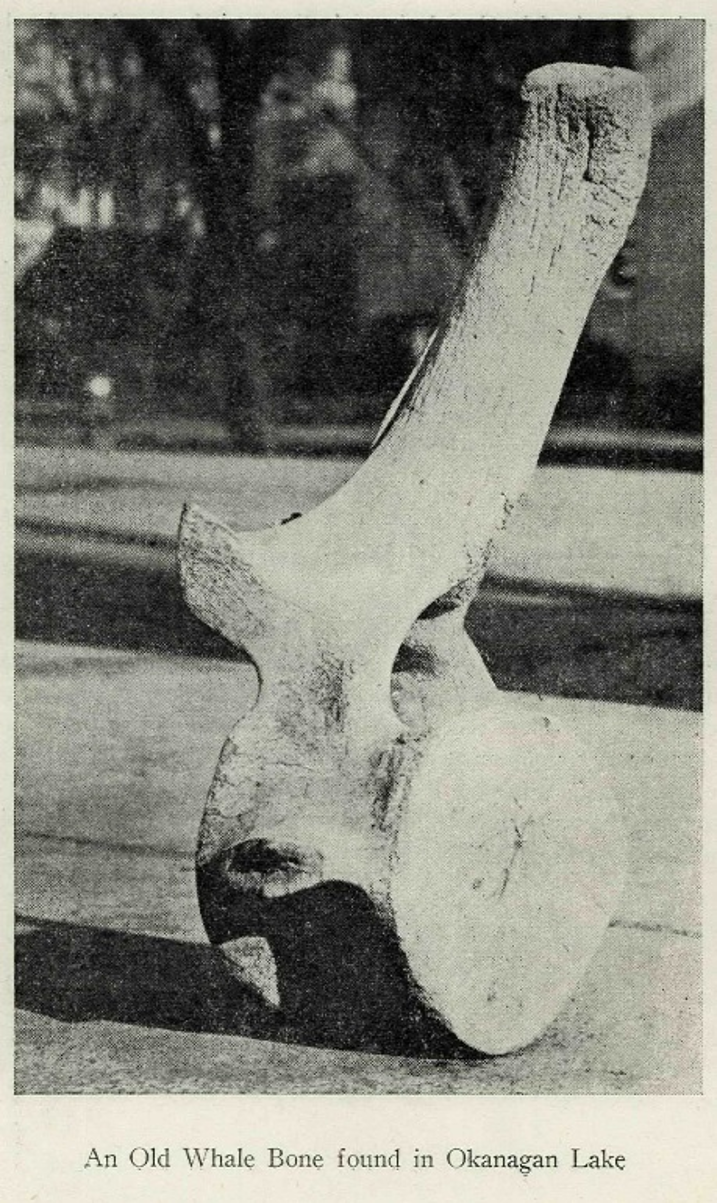Is it possible that a large undiscovered species could exist in Okanagan Lake? The legend of Ogopogo goes back to long before European Settlers arrived in the Okanagan Valley. Sightings were reported by early settlers in the mid-to-late 1800s. The first reported encounter was in 1855 when Métis settler, John McDougall, was crossing the lake with his horses tied behind his canoe, as he had done several times before. The horses were pulled under the water and he had to cut the ropes to stop the canoe from sinking. The first reported sighting of Ogopogo by a European Settler was in 1872 when Susan Allison was certain that she saw a dinosaur in the lake.
In Indigenous culture, nx̌aʔx̌ʔitkʷ—the word for Ogopogo in nsyilxcən, which is the language of the syilx/Okanagan people—is believed to be a spirit which takes on the form of an aquatic serpent while in Western culture, it is thought to be a large fish such as a sturgeon, a supposedly extinct species such as a plesiosaur or an underwater current that makes an unusual wave at the surface.
The Spirit of the Lake

Rattlesnake Island, Okanagan Lake (Photo by: Brian Sprout)
The story of the sacred creature of the lake goes back at least a few centuries, and possibly even thousands of years, to the syilx/Okanagan people who called it “nx̌aʔx̌ʔitkʷ,” which means “Spirit of the Lake.” They feared and respected nx̌aʔx̌ʔitkʷ, although they did not consider it to be malevolent. They would make offerings to it when they crossed the lake near Rattlesnake Island, where it was said to live in a subterranean cave at Squally Point. The creature was depicted in petroglyphs and other forms of art as an aquatic serpent and was said to feed on kokanee salmon. Although nx̌aʔx̌ʔitkʷ is a spirit it also takes on a physical form. In comparison, the nsyilxcən word for rattlesnake is “x̌aʔx̌aʔúlaʔxʷ,” which means “Spirit of the Land.” These sacred creatures serve as reminders to take care of the water, the land, and the environment.
The Sturgeon

Image: Atlantic Sturgeon (By Duane Raver/US Fish and Wildlife Service)
There could be sturgeon in Okanagan Lake however there have never been any official reports and eye-witness accounts have not been verified. White sturgeon are indigenous to other BC lakes and rivers including the Columbia River which connects to the Okanagan Lake system via the Okanagan River. However, dams were built by the 1920s and have since blocked access to the lake from the rivers and also blocked access to spawning habitat for any sturgeon which may exist in the lake. Any sturgeon alive in the lake today would have been living there for over 100 years. They are a long-lived fish and can grow up to 6 m in length. They are bottom feeders and rarely come to the surface. Okanagan Lake is a large lake with a length of 135 km and depths up to 232 m. Furthermore, there are subterranean caves that may connect the lake to other lakes in the valley and Ogopogo has been observed in some of these other lakes as well. Ogopogo sightings are often described as resembling a log floating in the water and this certainly matches the description of a sturgeon. However, Ogopogo is often said to be much larger than any known sturgeon and sturgeon are not known for tipping over canoes or pulling horses under the water.
“When the bridge was under construction in the mid-1950s, divers who helped build it told stories of large aquatic animals they were not able to identify, swimming close by. It frightened some into quitting, while others would discount it as being nothing but a large lingcod or lake sturgeon. The latter theory was more comfortable to live with as the divers still had a job to do .” - Arlene Gaal (2001)
A Living Fossil

Image: Plesiosaurus (By Dmitry Bogdanov)

Image: Basilosaurus (By Pavel Riha)
Many species which were once thought to be extinct have been discovered still alive. The more fossils and new species are discovered, the longer their known geological age ranges become. The coelacanth fish is the classic example of a living fossil, once thought to have gone extinct along with the dinosaurs at the end of the Cretaceous Period, until one was found living in the Indian Ocean in 1938. Ancient accounts of dragons go back to the earliest civilizations and may be describing the last living dinosaurs. For example, Leviathan and Behemoth were described in detail in ancient Hebrew texts, along with several other known animal species. Leviathan is an aquatic carnivorous dragon which fits the description of a mosasaur while Behemoth is a herbivorous dragon which resembles a sauropod. It has been suggested that Ogopogo could be a living dinosaur such as a plesiosaur or a prehistoric whale such as a basilosaurus. Although these species would need to come to the surface for air, they gave birth to live young and would not need to nest on land. Perhaps in ancient times, and possibly even in modern times, a dragon was observed in Okanagan Lake.
A Wave

Okanagan Lake (Photo by: Matt Ferguson Photography)
There is no doubt that a strange disturbance has often been observed and photographed on the surface of Okanagan Lake. It appears when the lake is otherwise calm and there are no boats on the water. Anyone who has seen this phenomenon knows that it is no ordinary wave. Exactly what causes this disturbance is a matter of debate. It may be the result of underwater currents, rising gases, seasonal overturn, and changing temperatures in the lake. Most of the time when people think they see Ogopogo they are most likely seeing nothing more than rogue waves. Other sightings can be explained as river otters, beavers, schools of fish, objects floating in the water, hoaxes or one too many drinks at the local wineries. However, not all the sightings can be easily explained and there are several cases where large groups of people all claimed to have seen the same thing. In 1968, the first film, known as the Folden Film, was taken of a large object surfacing in Okanagan Lake which appeared to be over 20 m long. Scientific analysis of the footage confirmed that there indeed was an object that surfaced in the lake although its size was not determined. Several pictures and videos have been taken in the decades since; however, nothing has been conclusive. More recently, in 2019, a video was featured in Global Okanagan News of large waves moving quickly over a calm surface on Skaha Lake, which is directly connected to Okanagan Lake via the Penticton Channel.

Image: An Old Whale Bone Found in Okanagan Lake (By Okanagan Historical Society 1945)
There have also been some interesting sonar images that have been taken in Okanagan Lake, including one of a 12 m long object which was detected during a Japanese expedition in the year 2000. In the late 1800s, a vertebrate bone was found in Okanagan Lake, which was thought to be from a whale. It went missing from the museum and it was never determined what species it was from or how it got into the lake. Whether Ogopogo is an actual animal or not, in 1989 it was listed under the BC Wildlife Act, making it illegal to hunt or disturb the species.
There are multiple things people have seen in the lake which they believe to be Ogopogo and there are various ideas about what kind of animal it could be. There is evidence to suggest that a cryptid species could be looming under the water. It is possible that Ogopogo could be an aquatic serpent, a giant sturgeon or a prehistoric species which has lived to modern times. Whatever species it may be, it is severely endangered and it is important to be respectful of the creature and its habitat. The old days of blurry, low-quality pictures and videos are over and we have entered into a new era of Ogopogo research. If you live in the Okanagan or plan on visiting, make sure to keep your cameras ready, your eyes peeled, and your minds open because you might just see Ogopogo.








